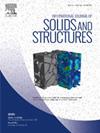Synchronous enhancement of extreme-damping and stiffness in elastic mechanical metamaterials via self-tensioning friction mechanism
IF 3.4
3区 工程技术
Q1 MECHANICS
International Journal of Solids and Structures
Pub Date : 2025-02-12
DOI:10.1016/j.ijsolstr.2025.113282
引用次数: 0
Abstract
Reusable mechanical metamaterials with both high energy-dissipating and load-bearing features are ideal candidates for widespread dynamic applications, ranging from impact mitigation to vibration suppression. Despite great demands, the existing designs either exhibit limited damping or stiffness, and perhaps work well only for one-time use. To reconcile these contradictions, a synchronous enhancements strategy of damping and stiffness is proposed to create novel mechanical metamaterial by replacing the viscous damping in the viscoelastic material Kelvin-Voigt constitutive to frictional damping, exemplified by auxetic self-tensioning friction damping metamaterials (FDM). They trigger an embedded sliding friction behavior through auxetic effect to achieve energy dissipation, which especially shows high stiffness while achieving extreme damping ability synergistically under large compressive strain. This synchronous enhancement mechanism is analysed by combining finite element modelling, theoretical analysis, and experimental validation. These innovative mechanical metamaterials with repeatability and self-recoverability have broad applications in engineering materials-structures-systems for energy-dissipation and load-carrying.
可重复使用的机械超材料同时具有高能量耗散和高承载特性,是广泛动态应用的理想候选材料,应用范围从减缓冲击到抑制振动。尽管需求巨大,但现有设计要么表现出有限的阻尼,要么表现出有限的刚度,也许只能一次性使用。为了调和这些矛盾,我们提出了一种同步增强阻尼和刚度的策略,通过将粘弹性材料开尔文-伏依格特构成中的粘滞阻尼替换为摩擦阻尼,创造出新型的机械超材料,例如辅助自张力摩擦阻尼超材料(FDM)。它们通过辅助效应触发嵌入式滑动摩擦行为以实现能量耗散,特别是在大压缩应变下协同实现极强阻尼能力的同时显示出高刚度。我们结合有限元建模、理论分析和实验验证对这种同步增强机制进行了分析。这些具有可重复性和自恢复性的创新机械超材料在工程材料-结构-系统的能量耗散和负载承载方面具有广泛的应用前景。
本文章由计算机程序翻译,如有差异,请以英文原文为准。
求助全文
约1分钟内获得全文
求助全文
来源期刊
CiteScore
6.70
自引率
8.30%
发文量
405
审稿时长
70 days
期刊介绍:
The International Journal of Solids and Structures has as its objective the publication and dissemination of original research in Mechanics of Solids and Structures as a field of Applied Science and Engineering. It fosters thus the exchange of ideas among workers in different parts of the world and also among workers who emphasize different aspects of the foundations and applications of the field.
Standing as it does at the cross-roads of Materials Science, Life Sciences, Mathematics, Physics and Engineering Design, the Mechanics of Solids and Structures is experiencing considerable growth as a result of recent technological advances. The Journal, by providing an international medium of communication, is encouraging this growth and is encompassing all aspects of the field from the more classical problems of structural analysis to mechanics of solids continually interacting with other media and including fracture, flow, wave propagation, heat transfer, thermal effects in solids, optimum design methods, model analysis, structural topology and numerical techniques. Interest extends to both inorganic and organic solids and structures.

 求助内容:
求助内容: 应助结果提醒方式:
应助结果提醒方式:


